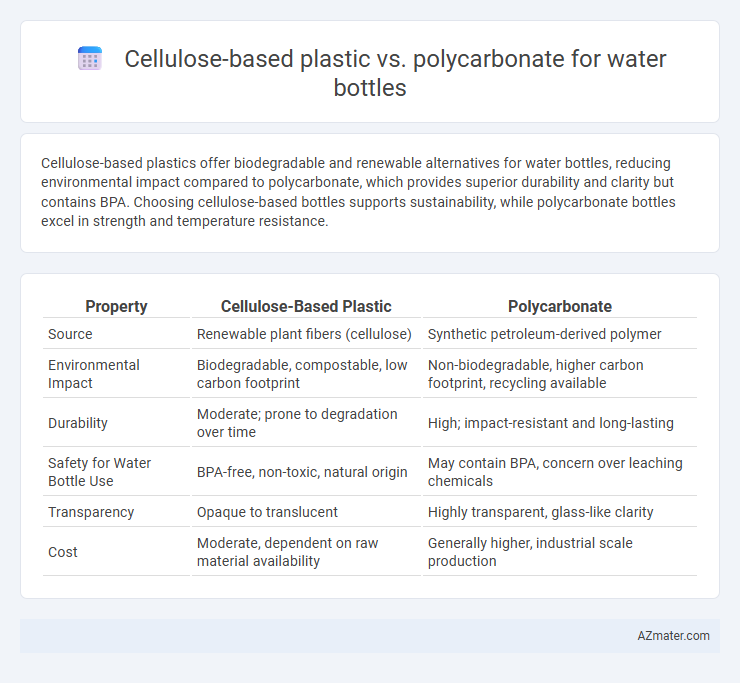Cellulose-based plastics offer biodegradable and renewable alternatives for water bottles, reducing environmental impact compared to polycarbonate, which provides superior durability and clarity but contains BPA. Choosing cellulose-based bottles supports sustainability, while polycarbonate bottles excel in strength and temperature resistance.
Table of Comparison
| Property | Cellulose-Based Plastic | Polycarbonate |
|---|---|---|
| Source | Renewable plant fibers (cellulose) | Synthetic petroleum-derived polymer |
| Environmental Impact | Biodegradable, compostable, low carbon footprint | Non-biodegradable, higher carbon footprint, recycling available |
| Durability | Moderate; prone to degradation over time | High; impact-resistant and long-lasting |
| Safety for Water Bottle Use | BPA-free, non-toxic, natural origin | May contain BPA, concern over leaching chemicals |
| Transparency | Opaque to translucent | Highly transparent, glass-like clarity |
| Cost | Moderate, dependent on raw material availability | Generally higher, industrial scale production |
Introduction to Water Bottle Materials
Cellulose-based plastics are derived from renewable plant fibers, offering biodegradable and eco-friendly alternatives to conventional plastics for water bottles. Polycarbonate, a durable and transparent thermoplastic, provides high impact resistance and clarity but poses environmental concerns due to its petrochemical origin and BPA content. Comparing these materials highlights the trade-offs between sustainability and performance in water bottle manufacturing.
Overview of Cellulose-Based Plastics
Cellulose-based plastics, derived from renewable plant fibers, offer a sustainable alternative to conventional polycarbonate materials in water bottles by significantly reducing environmental impact due to their biodegradability and lower carbon footprint. These bioplastics maintain good mechanical strength and water resistance, making them suitable for everyday use while minimizing toxic chemical leaching associated with polycarbonate bottles, which commonly contain BPA. Increased consumer demand for eco-friendly products and growing regulations against petrochemical-based plastics support the adoption of cellulose-based plastics in water bottle manufacturing.
Understanding Polycarbonate Plastics
Polycarbonate plastics are widely used for water bottles due to their high impact resistance, clarity, and durability, making them a practical choice for long-term use. Unlike cellulose-based plastics, polycarbonate offers superior strength and thermal stability, withstands repeated use without degrading, and resists cracking under stress. However, concerns over bisphenol A (BPA) leaching from polycarbonate bottles have led to increased demand for BPA-free alternatives and more sustainable options like cellulose-based plastics.
Production Processes Compared
Cellulose-based plastic water bottles are produced through chemical modification of cellulose fibers derived from plants, involving processes like esterification that enhance biodegradability and reduce environmental impact. In contrast, polycarbonate bottles are synthesized through polymerization of bisphenol A and phosgene, resulting in a durable, clear plastic with high impact resistance but a complex production process that emits more greenhouse gases. The cellulose-based production emphasizes renewable raw materials and lower carbon footprint, whereas polycarbonate manufacturing relies heavily on petrochemical inputs and energy-intensive facilities.
Environmental Impact and Sustainability
Cellulose-based plastics for water bottles offer superior biodegradability and reduce reliance on fossil fuels compared to polycarbonate, which is derived from non-renewable petroleum resources and can release bisphenol A (BPA), a harmful chemical. The lower carbon footprint and renewable origin of cellulose-based plastics make them a more sustainable choice, contributing to decreased plastic pollution and enhanced compostability. Polycarbonate bottles, while durable, pose greater environmental risks due to their slow degradation and potential for releasing toxins, undermining long-term sustainability goals.
Safety and Health Considerations
Cellulose-based plastics for water bottles are derived from natural renewable resources, offering biodegradability and reduced chemical leaching risks, making them safer for long-term human health compared to polycarbonate. Polycarbonate contains bisphenol A (BPA), a chemical linked to hormonal disruptions and potential toxicity, raising significant safety concerns during extended use or exposure to heat. Choosing cellulose-based bottles mitigates exposure to harmful substances and supports sustainable health-conscious consumption.
Durability and Performance Differences
Cellulose-based plastics offer moderate durability with biodegradability, making them eco-friendly but prone to degradation under prolonged water exposure and impact stress. Polycarbonate water bottles exhibit superior toughness, high impact resistance, and excellent thermal stability, ensuring long-term performance without cracking or warping. The choice between materials hinges on balancing environmental sustainability and the need for robust, long-lasting water containers.
Cost Analysis and Market Trends
Cellulose-based plastics generally incur higher production costs due to the complexity of sourcing and processing natural fibers, while polycarbonate offers a more cost-effective solution with scalable manufacturing. Market trends indicate rising consumer demand for sustainable materials, driving increased investment and innovation in cellulose-based water bottles despite their premium price point. Polycarbonate remains dominant in the water bottle market due to affordability and durability, but shifting preferences toward eco-friendly alternatives are accelerating the growth of cellulose-based plastics.
Consumer Preferences and Perception
Consumers increasingly prefer cellulose-based plastics for water bottles due to their biodegradability and eco-friendly appeal, aligning with growing environmental concerns. Polycarbonate bottles are valued for durability and clarity but face skepticism over potential BPA-related health risks affecting user perception. The shift towards sustainable materials highlights a trend where transparency about chemical safety and environmental impact heavily influences consumer choices.
Future Prospects in Water Bottle Materials
Cellulose-based plastics present a sustainable alternative to polycarbonate in water bottle manufacturing, offering biodegradability and reduced environmental impact due to their renewable plant-based origin. Innovations in cellulose extraction and polymer modification enhance mechanical strength and water resistance, positioning cellulose-based plastics as increasingly viable for durable water bottles. Polycarbonate remains favored for its toughness and clarity, but ongoing regulatory restrictions on bisphenol A (BPA) strengthen the case for cellulose-based alternatives in future eco-friendly water bottle designs.

Infographic: Cellulose-based plastic vs Polycarbonate for Water bottle
 azmater.com
azmater.com